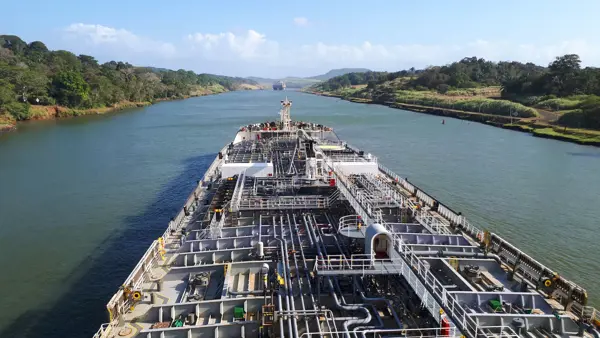Key Impacts to Manufacturers:

Navigating Global Supply Chain Disruptions Amidst the Panama Canal Drought

Get ahead of your supply chain vulnerability issues
The Panama Canal has been making headlines for reasons that extend beyond its engineering marvels, and this is the latest illustration of how essential components of worldwide supply chains can unexpectedly come to a halt. The critical waterway connecting the Atlantic and Pacific Oceans is grappling with a severe drought, sending ripples through the global supply chain, and demonstrating how accelerating climate change is an ongoing crisis.
Per CNBC, 40% of all U.S. container traffic travels through the canal, a total of $270 billion in cargo annually, and by February, they will be cutting vessel traffic by 40-50%.
Disruptions and inflationary pressures of this kind are unlikely to cease in the ongoing volatile and uncertain global landscape.
Delays and Increased Costs
Those heavily reliant on the Panama Canal for their supply chain are now facing significant delays, with container lead times rising rapidly and shipping costs reaching record highs. Vessels often must reduce their cargo to navigate the shallower waters, increasing the number of trips, which, in turn, escalates transportation costs. If they choose an alternate route, it will take much longer for the cargo to arrive.
Inventory Shortages
As delays become more frequent, manufacturers are struggling to maintain adequate inventory levels. This can lead to shortages, affecting their ability to meet customer demands and fulfill orders on time.
Supply Chain Disruptions:
The Panama Canal drought isn't an isolated issue. It's a domino effect impacting ports, transportation networks, and warehouses worldwide. It will be a struggle to coordinate the complex web of supply chain components.
Fortuitously, numerous businesses began diversifying their supply chains during the pandemic, but as time progresses, ramifications to the supply chain are on the rise, and manufacturers will have no choice but to respond by developing a more resilient supply chain. It is imperative to take a proactive and future-oriented approach to supply chain optimization and risk mitigation strategies.
At the very least, start by evaluating your existing supply chain with the checklist below and focus on addressing the most critical areas for enhancement.
How to Optimize Your Supply Chain and Minimize Risks Associated with Disruptions:
- 1
Transform Your Supply Chain Management
Founded on the core principles of adaptability, responsiveness, and flexibility, Demand Driven Material Requirements Planning (DDMRP) is the ideal solution for modern, intricate supply chains. Seamlessly integrated with Microsoft Dynamics, it enhances inventory and supply chain management by responding to real-time market demands.
- 2
Enhance Visibility
Microsoft Dynamics 365 provides real-time visibility across the entire supply chain. With IoT and AI capabilities, you can monitor your inventory, transportation, and production processes, allowing you to make data-driven decisions.
- 3
Gain Predictive Analytics
By harnessing the power of Azure AI, you can forecast disruptions in advance. Microsoft's AI and machine learning tools can help identify potential supply chain issues, enabling proactive mitigation strategies.
- 4
Utilize Cloud-Based Collaboration
Dynamics 365's cloud-based platform promotes collaboration among different supply chain partners, ensuring smooth communication even during crises. This facilitates better coordination when disruptions occur.
- 5
Ensure Scalability and Adaptability
Microsoft's solutions are designed to be scalable and adaptable. As your business grows or faces changing market conditions, Dynamics 365 can evolve with you to meet your specific needs.
- 6
Simulate Supply Chain Scenarios
With Dynamics 365 Supply Chain Management, manufacturers can simulate different scenarios and assess their impact on the supply chain. This helps in making informed decisions and contingency planning.
The Panama Canal drought is a stark reminder of the vulnerabilities in our interconnected world. Manufacturers who invest in technology solutions like Microsoft Dynamics 365 are better equipped to navigate such challenges. By enhancing visibility, utilizing predictive analytics, and fostering cloud-based collaboration, businesses can minimize supply chain risks and continue to deliver products to their customers, regardless of the external disruptions that may arise. It's time for manufacturing companies to embrace the power of technology to ensure resilience and agility in their supply chains.
DIVE INTO
Supply Chain Resiliency Resources
